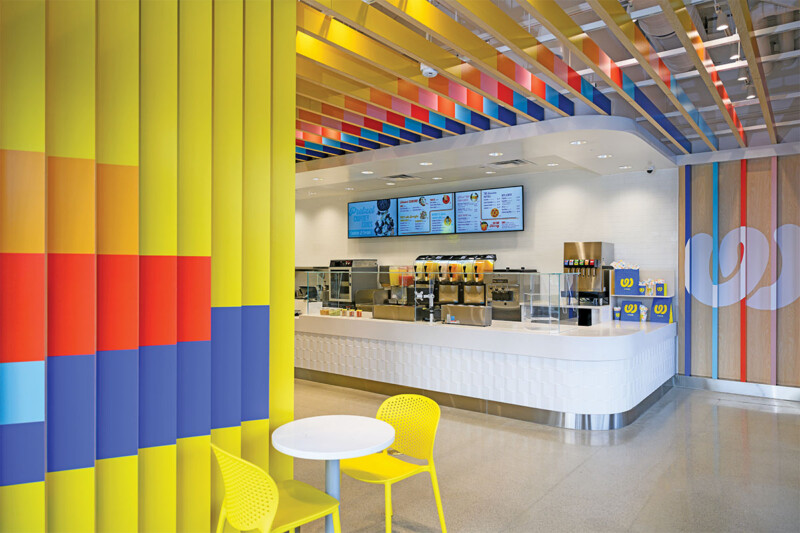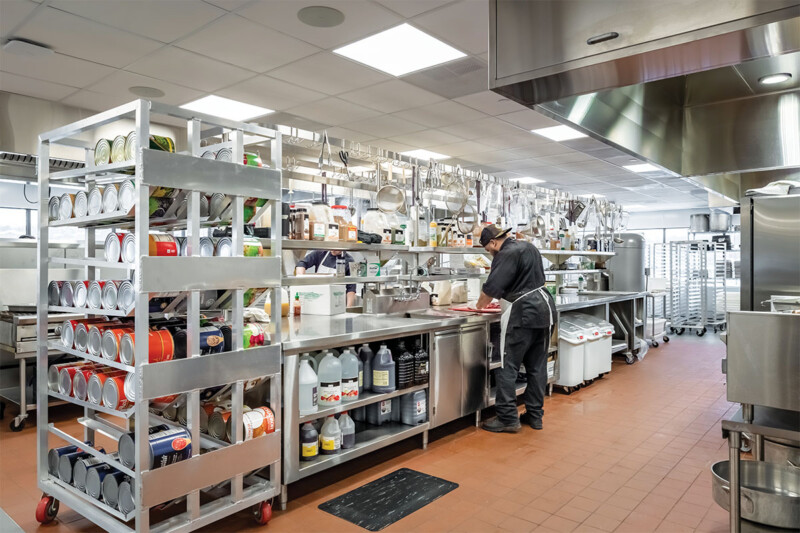Quick-Service Concept Hiya Taco Powered by Back-of-House Cook-Chill System

When Toro Taco Restaurant Group, a Milwaukee-based operator of the six-unit, full-service restaurant BelAir Cantina, was brainstorming new concepts that would be easier to operate and more cost-effective for future growth, they came up with a quick-service concept called Hiya Taco.
What sets Hiya Taco apart from other taco shops, and from its sister concept, is a back-of-house production line powered by a compact cook-chill system. In the front-of-house, Hiya Taco features 1970s-inspired decor with bold colors, signage made of supersize embossed plastic labels and visual cues guiding guests to pick up or order in that includes a “Nice to see ya!” greeting in large letters.
Hiya Taco opened in August in Shorewood, Wis., just north of Milwaukee, in a revamped burger shop. COVID-19-imposed social distancing has limited indoor seating to 12, though a generously sized patio with a fire pit encourages guests to eat on-site when weather permits.
Despite the pandemic, the concept has exceeded expectations. Opening sales were about 30% above projections.
“Hiya Taco began strong even though we started in a pandemic because the pandemic itself changed the way we dine,” says Matt Roman Lopez, Toro Taco operations director. “Fast, convenient, and safe restaurants that present a full-service restaurant quality in a quick-service environment is what guests now want. We have strong expectations for the months ahead, although the pandemic makes it hard to gauge where sales will level out come this time next year.”

Visual cues on the wall at Hiya Taco’s entrance guide guests to either the pickup or order point.
MENU/SEGMENT: Quick-service tacos
FOUNDED: 2020
NUMBER OF UNITS: 1
PARENT COMPANY: Toro Taco Restaurant Group, Milwaukee SIZE: 2,431 sq. ft.; back-of-house: 892 sq. ft.
SEATING: 12 seats indoors with social distancing
FF&E PACKAGE: $99,700
CONSULTANT/DESIGN FIRM: Steve Starr, principal; Jeff Cangro, project manager; Brenna Johnson, designer; Starr Design, Charlotte, N.C.
CLIENT: Kristyn Eitel, partner; Matt Roman Lopez, operations director; Leslie Montemurro, partner; Noe Zamora, chef/partner, Toro Taco Restaurant Group
DEALER: Fein Brothers, Milwaukee
MANUFACTURERS’ REP: Chuck Asher, executive chef, Swanson-Girard, Charlotte, N.C.
WEBSITE: hiyataco.com
First Bite
Goals for Hiya Taco centered on high-quality food and cost-effective operations, which is how its kitchen came to include combi ovens and a blast chiller as well as a griddle, fryer bank and sandwich prep table.
“Great food and efficient operations can be intertwined,” says Steve Starr, principal of Starr Design, Charlotte, N.C., who served as the lead foodservice consultant on the project.
Starr describes a research project conducted by Yum Brands about five years ago that opened his eyes to the potential of cook-chill in a quick-service setting. “When consumers [in the study] were asked how they defined food quality, the only totally objective data everyone could agree on was the temperature and consistency of the first bite,” Starr says. “If the food is piping hot with a ‘not mushy’ texture for that first bite, consumers tend to rate it as ‘high quality.’”
It was the goal of delivering optimal first-bite temperature and texture that led Starr to propose using institutional foodservice stalwarts—cook-chill and retherm for the concept.
“The combi ovens batch cook proteins to an almost-done state, then the blast chiller rapidly lowers the cooked food temps from 140°F to 40°F so it can be safely held,” Starr says. “When an order comes in, cooks heat and reverse-sear par-cooked proteins on the griddle in a fraction of the time it would take to cook from raw.” (Hiya Taco service times average three to five minutes, Roman Lopez notes.)
Hiya Taco’s cook-chill system saves on labor by smoothing out the food-prep workload. “All the beef and pork can be prepared two or three days per week, and chicken and vegetables on alternating days, rather than having to prep all the proteins daily,” Starr says.
The combi ovens’ programmable cook cycles boost food consistency, as well. “All cooks need to do is put the food into the combi oven and press the correct button. Food is cooked according to the chef’s preprogrammed directions,” he says.
The shift from full-service cooking and holding to cook-chill-enhanced quick-service methods required a new mindset from classically trained BelAir Cantina Chef/Partner Noe Zamora, who also developed the menu at Hiya Taco. “It took time and multiple tests on Chef Zamora’s part to achieve the flavor profiles he wanted, at the temperatures he wanted,” Starr says. “He finally had that ‘aha!’ moment when he was working with the combi oven back in his own restaurant.”
“We were really excited at the possibilities of the combi oven/blast chiller system,” Roman Lopez says. “None of us had ever used a combi before, although we were definitely aware of them.”
“We were really excited at the possibilities of the combi oven/blast chiller system. None of us had ever used a combi before, although we were definitely aware of them.” —Matt Roman Lopez, Toro Taco

The cook-chill approach, using a combi oven and blast chiller and then retherming to order on the griddle, helps Hiya Taco cooks deliver that optimal first-bite temperature and texture in a quick-service time frame.
COVID Complications
Hiya Taco’s design work began in July 2019, and construction began in December. The pandemic’s March shelter-in-place order caused unexpected operational flow changes for Hiya Taco, which was by that point getting very close to opening.
“We designed Hiya Taco so that line cooks would put completed orders in the expo window on waxed paper. The expeditor would either plate the tacos for dine-in customers—a 10-second process—or wrap and bag them for carryout—a 30-second process,” Starr says. “The pandemic forced us to reevaluate how food would be presented to guests.”
After much discussion, the team decided to nix the dual process and instead wrap all orders to-go—including dine-in orders.
“This seemingly simple change meant we had to rethink everything—where to store the extra carryout supplies, how to make the expo station work with two to three people instead of one to two people at peak times to accommodate the longer times needed to wrap to-go orders. We also needed to adjust the POS system to indicate which orders are ‘order-ahead’ versus ordered at the counter,” Starr says.
“The hard part was not the pivot, it was figuring out which way to pivot,” Starr adds. “No one knew if we would have to make the change for three weeks, or months or years.”

The Hiya Taco design team expanded the expo window from a narrow pass-thru opening to a counter-height, 61/2-ft.-wide window showcasing the griddle.
Hiya, Kitchen
The design team kept as much of the equipment from the former burger shop’s 892-sq.-ft. kitchen as possible, including the hood, griddle and general layout. Everything else changed.
“We took out some of the fryers and an automated churro maker that came with the restaurant to add the combi ovens and blast chiller. We also reworked the dish area and added self-contained prep workstations,” Starr says.
The biggest makeover is to the chef’s line, which can be scaled up or down, labor-wise, depending on order volume. “We figured out how many 1/6 and 1/3 cold pans each station would need,” Starr recalls. “That worked out to two taco assembly stations; a grill and tortilla station; and a salad, fryer and appetizer station. We added
several smaller refrigerated prep units instead of one central unit. This allows for one person to handle more than one station at slow times, and up to six people, back-of-house, during peak times. If we just used one central refrigerated unit for all the back-of-house stations, the staff would have been on top of each other during peak times.”
Another big change opened Hiya Taco cooking action to customer view. The design team expanded the expo window from a narrow pass-thru opening to a counter-height, 61/2-ft.-wide window showcasing the griddle. “We wanted guests to see the fresh ingredients in the make-tables, and their tacos being cooked to order,” Starr says.
Finally, the team also created a more robust prep area, with sink, worktable and overshelves. They also added a three-compartment sink to supplement the warewasher.

With social distancing, Hiya Taco offers indoor seating for about 12 people. An outdoor patio provides additional seats. Employees can open garage door-style windows when weather permits.
Next Stop
At press time, Milwaukee officials had just reimposed 25% occupancy restrictions in response to a COVID resurgence. When asked about expansion plans for the coming year, Roman Lopez was optimistic, but vague because of pandemic uncertainty.
“We would love to open more Hiya Tacos,” Roman Lopez says. “We’ve been exploring sites in Wisconsin and surrounding states for our next location.”

When an order comes in, Hiya Taco employees heat and reverse-sear partially cooked proteins on the griddle in a fraction of the time it would take to cook from raw. Hiya Taco service times average three to five minutes.
Key Equipment
- Beverage-Air/Ali Group sandwich prep tables, worktop and u/c refrig., worktop freezer, open-air merchandiser
- AccuTemp griddles (existing) True refrig. base w/drawers Alto-Shaam combi ovens, blast chiller, drop-in food well
- Hatco food wells, fry holding stations
- Imperial Range cheesemelter
- Pitco/Middleby fryers
- Perlick beer dispenser, drip pan
- Hoshizaki ice machine w/bin
- A.O. Smith water heater Lancer drop-in ice dispenser
- Krowne blender station, glass storage, ice bin
- Micro Matic remote beverage cooling system, gas blender
- John Boos sinks, dish tables
- CaptiveAire hoods (existing)
- Ecolab warewasher (existing)
RELATED CONTENT
- Advertisement -
- Advertisement -
- Advertisement -
TRENDING NOW
- Advertisement -
- Advertisement -
- Advertisement -


